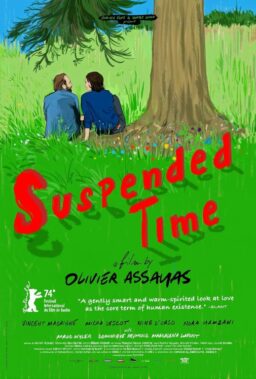There’s something about Norman Jewison’s 1985 film “Agnes of God,” which just turned 40, that sinks deep into my bones. It brings on a feeling like being stunned. It happens again and again throughout the film, every time I watch, every time Meg Tilly is on screen as the titular Agnes. In one scene, she is being hypnotized, and though her eyes are closed, tears still seep out—one glistens on her lashes like a gemstone—and I know with a knowledge that doesn’t deal in words but rather in feeling that what I am seeing is the truth, the truth of a woman’s experience.
The interesting thing is, we don’t get through Agnes a universal experience of womanhood, because Agnes is anything but an average woman. Uneducated and dreamy, Agnes can be read either as a saint or a fool, depending on what side of the bed you woke up on this morning. The young woman exists in the middle ground between reality and magic, a sacred liminal space difficult to describe using failsafe words, and yet Tilly allows us to feel it through Agnes with a preternatural clarity. Through swoons and tears, sighs and paroxysms, through recollections that switchback midway through their telling, Agnes shows us what it feels like to believe oneself in one’s own stories. “Agnes of God” shows us what it looks like to honor the self.
In Agnes, we don’t receive a linear document of the events that make up a life so much as what it truly feels like to be Agnes. Tilly’s performance uses intuitive language—affects in the face and body, how something is said, as opposed to what is said—which is most apt to carry the spiritual or liminal, to allow us some time in Agnes’s mind. Mercurial and illogical as it may be, certain in its ambiguity as it is, we see through Tilly what it is to be Agnes, and in seeing her feelings, we are in turn touched by them. “Agnes of God” allows me to carry Agnes’ breath, her words, her feelings; we carry her experience of being in the world, and it feels just as real, as heavy and poignant, as a tear trailing down our cheek.
It struck me as strange then, in the face of the honesty that I have always sensed in Tilly’s portrayal, that the common thread among the critical reception for “Agnes of God,” whether praiseworthy or detractionary, is that it is dissatisfying. Though it received three Academy Award nominations and Tilly won a Golden Globe, the film seems to make many uncomfortable with its many loose ends. Critic for The New York Times Janet Maslin called the film a “three-character melodrama” that combines “mystery, theology and psychology” but leads ultimately to an “anticlimactic resolution.” Roger Ebert described the film as having a “clouded agenda,” a mess of unanswered questions that takes the “basic questions of human morality and treats them on the level of ‘Nancy Drew and the Secret of the Old Convent.’”

The film follows Jane Fonda’s Dr. Martha Livingston, a court-appointed psychiatrist, who is tasked with determining the sanity of a novitiate, Agnes. Agnes is discovered one night at her convent, covered in blood and screaming in agony, a dead newborn baby stuffed into the wastebasket in her austere room. Agnes is charged with manslaughter. As Livingston performs her investigation, she learns that Agnes not only does not recall being pregnant, giving birth, or even the baby, but is also absolutely unaware of how the world works, let alone how babies are conceived. Agnes was kept at home and denied education by a mother who abused her till the day she died, at which point Agnes immediately joined the convent. Anne Bancroft’s Mother, Miriam Ruth, believes Agnes to be a pure innocent and wants to protect her from the world, while Doctor Livingston wants Agnes to confront her past and present, to hold agency and autonomy. In a way, Agnes satisfies both, remaining protected and achieving autonomy.
The film does portray a conflict between faith and science, but it is subtle and faltering, giving and taking. Mother Miriam wants everyone in her convent to understand that they exist within the context of modernity, that menstruation, for example, is completely normal, and a woman ought to eat to be healthy. Doctor Livingston, meanwhile, is deeply empathetic to religion, for she is a lapsed Catholic whose sister died in a convent. The conflict between science and religion seems as much to take place within each individual as it does between the two characters who personify the schools of thought and tradition. But the film is also Agnes, who stands between science and religion and wails and screams and bleeds; and it is upon her smiling face that the film ends.
Playwright John Pielmeier adapted his own Tony-winning Broadway play when he wrote the film’s script, and described the story as “a detective story, not only of the world, but of the mind and of the soul.” It makes sense then that critics went into the film expecting a mystery and were disappointed to see that nothing really gets solved, that no real answers are proffered. The oft-described clash between reason and religion that many feel the film portrays is, by the end, without a winner. Indeed, “Agnes of God” is a terrible mystery, but this is not to say that it is a terrible movie. It contains a little miracle that is worthy of a more penetrative and patient gaze. To read the film as a mystery is to only see the film superficially; it is to ignore Tilly’s Agnes’ plea for recognition. As a character sketch, this film is a marvel.
“Nobody believes me when I tell them anything,” Agnes says at the film’s beginning. “Nobody listens to me.” To read the film as a mystery is to read the film from the point of view of the courts, from the view of everyone but Doctor Livingston and Mother Miriam. The world around the convent and Doctor Livingston wants to put a label on Agnes, whether that be a murderer or an insane woman; they want to pass judgment on her or solve her and be done with her. And to put a label on Agnes is to ignore her, to overlook the fallible humanity that Tilly painstakingly sketches before us, and that persists after the final and official sentencing takes place.

“A miracle is a violation of the laws of nature,” wrote Enlightenment philosopher David Hume in 1748’s groundbreaking and, for the time, controversial (because of its suggestions of atheism) An Enquiry Concerning Human Understanding. And the laws of nature are determined by a steady experience. Hume laid the groundwork for modern epistemology, or our study of knowledge; his work on inductive logic impacts how we talk about causality and has immensely impacted scientific methodology. Hume writes that when it comes to miracles, we ought to reckon the miraculous phenomenon against past experience, or how we know the world to work, and if in the past no person has ever given a virgin birth, for example, then that is proof enough that nobody is giving a virgin birth now.
This reckoning, the weighing of present against past, leads to a conclusion, leads to a satisfying resolution, and this is a reckoning that we expect from Agnes of God. But the film staunchly, frustratingly refuses to perform it. Despite Doctor Livingston’s attempts before the courts, she never really does arrive at a definite and clean claim other than the large and permissive label of “insanity.” Doctor Livingston is never really able to make a concise declaration, no singular deduction, which is one that our culture has raised us to seek. At the film’s end, when Agnes is in court and the judge declares that she is not guilty by reason of insanity, Agnes stands and begins speaking and we think that we might finally get an answer as to who or what got her pregnant, who the father of her dead baby could be. But Agnes refuses to satisfy our desire for causes whose seeds Hume sowed so many years ago. She gets up and delivers a monologue that, within the building, stands for reason, science, and balanced justice, which makes no sense.
“I stood in the window of my room every night for a week, and one night I heard the most beautiful voice imaginable,” Agnes says softly, her words carrying the clipped cadence of one who has learned in isolation. “And when I looked, I saw the moon shining down on him. For six nights, he sang to me songs I’d never heard, and on the seventh night, he opened his wings to lay on top of me. And all the while he sang.” And Agnes begins singing a song that doesn’t feel religious or expository at all.
“I don’t know the meaning behind the song she sang,” says Doctor Livingston in voiceover in the film’s final moments. Though she is a doctor and ought to make sense of the irrationality that Agnes has delivered throughout the film, Doctor Livingston, too, refuses to answer to our expectations. “Perhaps it was a song of seduction, and the father was a field hand. Perhaps the song was simply a lullaby she remembered from many years ago and the father was love, and hope, and desire and a belief in miracles. I want to believe that she was blessed, and I do miss her, and I hope that she’s left something, some little part of herself with me. That would be a miracle enough, wouldn’t it?” Doctor Livingston, instead of clearing up matters, leaves us with a multiplicity of truths, a plurality of possibilities and realities, and worlds all holding equal credence. Agnes’ song is a soft moment of standing up for the self, of self-advocacy.
It is easy to see, in the shadow of the systems that have raised us, why Agnes is unreliable, why she would be a witness that Hume would immediately disregard in favour of the steady and predictable experience, which determines the laws of nature, of a man like himself: a man of “unquestioned good-sense, education, and learning,” whose experience will “secure us against all delusion.” From the point of view of our (patriarchal) Humean framework, according to which a fact is a fact because an educated man has experienced it with unwavering certainty over the course of a mindful life, Agnes’ words are certainly irrational, categorically insane, and delusional. And yet Doctor Livingston, the figure that stands for science in the clash that people believe this film to graph, hopes that she has been touched by Agnes’ irrationality.

Though it discards it, does our dominant framework, which champions rationality and clear causes of effects, also make Agnes’ experiences, her subjectivity, any less valid, any less true or immediate or real for her? I think our cultural desire for a singular and finite conclusion, a single satisfying answer to the mystery around Agnes’ pregnancy—this desire is certainly, inherently cruel and unforgiving, because in its search, it also wants to invalidate or override Agnes’ subjectivity. This is why I feel the film to be so transfixing, this is why my hairs stand on end when I watch Tilly, with her waxen face, stand tall before the courts. Even though it is frustrating, the film ebulliently honors the young woman’s experience.
Agnes is, compared to the average person, strange. Some might call her insane, others might call her a zealot, and others yet might call her a saint. She says she is haunted by her mother, literally—she sees her ghost often, a sodden specter who Agnes believes rises from the depths of hell to watch over and judge her. If she isn’t from hell, then why does she appear wet? Agnes asks Doctor Livingston and receives no answer. Agnes believes she is also looked after by a more benign woman’s spirit, a Madonna figure who tells Agnes that she is protected.
After Agnes gives birth, Mother Miriam offers the idea that the child could have been God’s, and Doctor Livingston balks at the suggestion. The doctor has found a secret passage that leads from the barn into the convent and that presents the possibility that Agnes could have snuck out to meet someone, that a man could have snuck in, that she seduced someone, or that she was raped. But which possibility is it? The film not only doesn’t ever have Doctor Livingston reach a clean diagnosis of Agnes’ psychological state, but it also doesn’t coherently explain the particularities around how Agnes got pregnant; all we ever get are Agnes’ words, her unique, distinct, personal testimony.
Though the least credible Humean witness, Agnes, receives the respect of space and time. The film allows Agnes to speak and share and express, to rhapsodize or get angry or frustrated, and Tilly carries Agnes’ feelings and words with such towering confidence and gusto, while also allowing them a normalcy, an anchor in measured or familiar reality. We don’t get melodrama here, nor do we get slapstick comedy. Tilly’s Agnes feels real, worthy of consideration, despite being so other. At one point, when she is in the confessional, the father has a hard time hearing her soft voice and asks her to speak up, so Agnes raises her mouth to where she sees his ear through the lattice of the confessional and shouts that she has bad thoughts about Mother Miriam sometimes. It’s a laugh-out-loud funny scene; though Agnes means it seriously, the confession isn’t as heavy or grueling as her other confessions, it’s mundane and real, and so adorable.
And then there are the hypnosis scenes. Doctor Livingston decides that the best way to get Agnes’ repressed memories of the night of the birth out of her is through hypnosis. “You are going to recall all the things that we want you to remember,” Fonda’s Livingston directs, guiding Agnes as she floats into sleep. Again, the film sets us up to expect “truth,” and we do get straightforward, terse facts for a few beats. Agnes finally vocalizes that yes, she did have a baby, something she has been refusing to countenance until now. But she still does not want to tell Livingston how the baby got into her, a refusal that the doctor respects.
As Livingston has Agnes re-live the night she gave birth, Agnes moves away from the objective truth to the subjective. “I feel as if I’ve eaten glass,” she describes. “I have to throw up,” she says, reliving the moment of retching. In guttural pain, she doubles over onto the floor. “Glass,” she gasps. “One of the sisters has fed me glass.” No matter that it’s untrue, it is what it feels like for Agnes. In her second hypnosis session, Livingston has Agnes go back not to the night she gave birth but to the night she conceived the baby. The entranced Agnes describes how an older sister saw “Him,” sent Agnes to “Him” that night. Agnes describes using the secret tunnel to get into the barn and there meeting “Him.”
Instead of depicting Fonda’s doctor desperately and painfully prying Agnes for details about “Him,” the film chooses to dramatize Agnes’ experience that night. In the barn dust, doves and owls surround Agnes. Maslin said the birds are a metaphor for sex, but the film is never conclusive about the sexual partner. We can’t say whether it is sex with a human or spirit, whether Agnes is even touched, for we never see or hear “Him,” we only see and hear Agnes’ voice in answer. She could just as easily be talking to nobody or be talking to one of her many ghosts or to god or the devil. Again, there is no single definitive and objective answer to what happened, literal or metaphorical, only Agnes’ face, words, and the feelings that Tilly wears.
“Wait, I want to see you,” Agnes says in her trance memory. When Livingston asks Agnes what she sees, she describes it honestly. “Halos,” she says, in religious awe. “Dividing and dividing, feathers of stars, falling. Falling into the iris of God’s eye. Oh, it’s so lovely, it’s so blue, yellow, black wings, brown blood. Red, His blood,” she says. Back in the present, her hands start bleeding from stigmata that spontaneously appear. “I hate him for what he did to me,” she says after a while. “For what he made me go through.” And when Livingston asks who did this to her, Agnes screams, “God.” “It was God. And now I’ll burn in hell because I hate Him.” She cries with her whole body, and we feel her anguish, her blunt conviction in her damnation.
The doctor finally takes Agnes back to the night of the birth and asks her what she did to the baby. Agnes says she held the baby and looked at it and thought, “This is a mistake, but it is my mistake, not mommy’s. God’s mistake.” With her hands outstretched as if in prayer, as if holding up a baby, Agnes explains she thought she could save the baby if she killed it: “I can give her back to God.” And then she smiles, because she fully believes she did save the baby. (Earlier in the film, Agnes explains her belief that good babies don’t cry, only bad babies cry and upset their parents; hers is a good baby that is accepted by God.) It’s the same smile Agnes wears after Livingston’s voiceover ends, after she is acquitted, and she is watching doves flutter about her. It’s a smile of contentment and peace—she has voiced her piece, has expressed her beliefs, has shared her truth, and she smiles, all goodness and light.
It is not lost on “Agnes of God” that Agnes’ case raises many questions—time and again, Doctor Livingston says she is searching for answers. Agnes even accuses the doctor of asking too many questions, and in response Livingston lets the young woman ask her as many questions as she likes. At the film’s very beginning, after Agnes has asked her fill of questions, she describes seeing the Madonna figure, “the lady who tells me things,” for the first time as a child. She is, of all things, staring at the sun when the figure appears. The figure tells Agnes she will be her companion, and then she begins to bleed. Agnes tries to catch her blood, but she doesn’t do a very good job because the sun leaves her momentarily blind. It’s objectively an irrational and silly little story, one that answers none of the questions that Doctor Livingston sets out to find answers to, and yet the film allows Agnes to share the silly little story. Tilly relates it with unguarded honesty, because she understands that it conveys Agnes’ lived reality, she understands that it honours the girl’s understanding of the world.
“Agnes of God” is consistently positioned as a battle between faith and science, a matter of one versus the other; and all battles are questions that have answers, clear winners and losers. This search for distinct and clear answers is what our modes of thinking, shaped by men who silence marginalized people’s voices, foster. And what gets lost in such traditional thinking, or mystery solving, is Agnes herself, a vibrant being whose experience the film takes pains to center. “Agnes of God” asks us to bear witness to one who rarely would be given the space to share her story. Carried by Tilly’s spellbinding performance, this film is a refusal to provide answers, and also a making space, an ask that we hold the words of someone like Agnes in our minds, maybe even in our bones. This sweet film, though disquieting, is an honest celebration of a quietly beautiful life.











